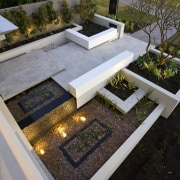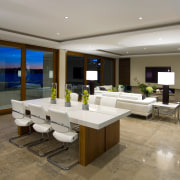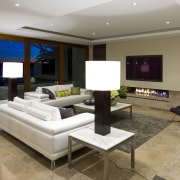Look both ways
To maximise the sun and provide views in two directions, this house has a strong transparency and terraces at the front and the rear
Designing a house can be like solving a jigsaw puzzle. There is a way to make everything fit you only have to find it.
For this new home project, it wasn't just about the square metres and fitting a large house onto a site that was formerly a tennis court. It was also about arranging the interior to maximise the best views in one direction and the sun on the opposite side of the house.
Architect Mark Rietveld of Giorgi Exclusive Homes in Perth says the site was also rather low, so his initial response was to elevate the house as high as possible.
"This was a way we could make the most of the views across a park, and also create a strong sense of entry. To this end, we created a generous undercroft with garaging for four cars and space for cellars and additional storage."
Rietveld says, however, that the main challenge was orienting the house to obtain the best views and sun, while still ensuring outdoor living areas were protected from the strong southwesterly winds.
The solution was to create a flowing, open-plan interior that opens to the front and rear of the house.
"Because the living area faces both north and south, we were able to capture the views to the south, which is the direction of the prevailing winds, while having an entertaining area to the north this still allows light to pass through the house. The result is a very open, transparent interior that has a direct relationship with the views on all sides."
Rietveld says the front door was positioned at the side of the house, to further take advantage of the potential for views across the front. With a path that steps up beside landscaped planters and bridges a reflection pool, this was also a way to create a sense of arrival.
To enhance the visual flow and the circulation through the house, the architect introduced a distinctive curved wall that wraps around the interior, starting at the entry.
"The curved element helps with the traffic flow, and opens up the interior to the view, in a very natural way."
To further enhance the indoor-outdoor link, large sliding doors open to an alfresco living area with an outdoor kitchen on the north side of the house. This seating area is contained beneath a low roof, which provides intimacy. But at one side the space soars to form a double-height volume that reinforces the sense of transparency and connection the alfresco area can be glimpsed from the family room on the floor above.
"With its large planter boxes, the alfresco living area feels like an outdoor area on the ground floor, but of course, this entire floor is elevated," says Rietveld.
The seamless flow of the indoor and outdoor living areas is helped by the use of the same limestone tile flooring throughout, and by the consistent, contemporary palette of steel, glass and wood. But different areas within the overall space, including the kitchen, dining and living areas, are clearly defined by suspended or coffered ceilings.
Leon House, who designed the kitchen in conjunction with Spago Interiors and the owners, specified a mix of chestnut wood veneer and sleek, lacquered cabinets.
"Chestnut is a long-revered wood that provides a sense of permanence," says House. "It also gives the kitchen visual warmth, and an organic feel, and is a subtle anchoring point. We have teamed it with lower cabinets painted in an urban grey tone, a colour-backed glass splashback in the same shade, and highly sculptural Essastone benchtops."
Stainless steel trim adds a contemporary horizontal accent to the upper cabinets, and the toekicks.
There is also a separate walk-in pantry providing additional bench space.
Rietveld says every room in the house has been designed to capture a view there is a glimpse of the Swan River from the kitchen. On the upper level, the layered roof form helps to frame the view from the family room.
The roof was also designed to ensure light would flood the top level. A large square cutout not only helps to visually lighten the apparent mass of the roof, but also allows light to reach down to the lower roof. Light reflecting off this roof reaches into the family room, through high clerestory windows.
The upper level also boasts a study, the master suite, two additional bedrooms, and a bridge across a void that is open to the entry below.
On the ground level stepped down from the alfresco living area there is a plunge pool, sundeck and additional planter boxes.
Credit list
at the front and the rear Architect
Interior designer
Roof
Tiling
Lighting
Kitchen cabinetry
Splashback
Tapware
Ventilation
Hot water system
Tub
Bathroom tapware
Builder
Kitchen designer
Pool
Blinds
Paints
Heating
Audiovisual equipment
Benchtops
Sink
Oven, microwave and dishwasher
Refrigeration
Bathroom vanity cabinets
Basin
Ventilation
Story by: Trendsideas
Home kitchen bathroom commercial design
Connected to the ocean
Contrast and connection
At one with the Amazon
















